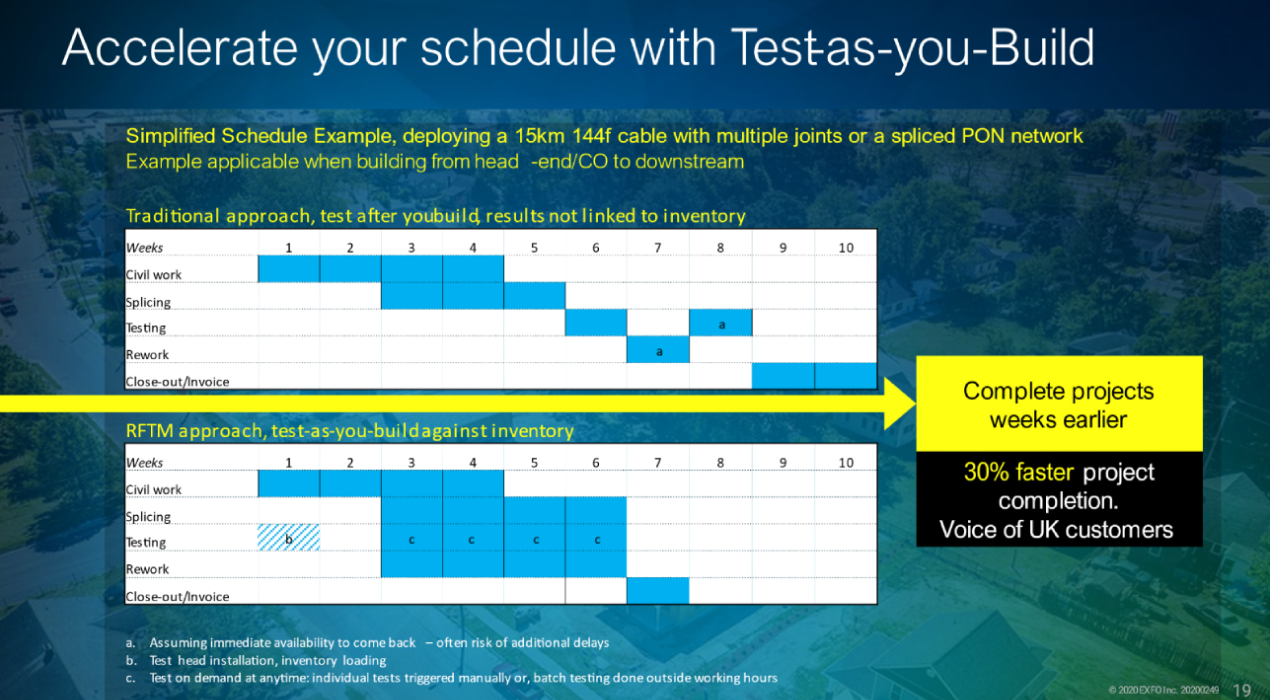Centralized fiber testing: “No marginal cost” testing in the fiber construction time-to-cash race
In the rapidly evolving landscape of fiber network deployment, field efficiency and cost-effectiveness are paramount. Traditional testing methods relying on portable equipment and manual labor have long been the standard. However, EXFO’s remote fiber testing and monitoring (RFTM) is ushering in a new era, reshaping the way we approach construction testing and enabling new and more efficient workflows. This article explores how RFTM eliminates the marginal cost of testing while delivering unprecedented flexibility for tests, real-time insight and faster time-to-cash.
Typical cable deployment
To establish a fiber connection between Site A and Site B, the fiber-optic cable must be installed along the designated pathway. Optical cable sections can vary in length from a few hundred meters to several kilometers. Terrestrial fiber network deployments typically use reels less than 2 km in length because longer cables are generally more expensive per meter and are more complex to manipulate due to their size (typically reserved for long distance and subsea applications). Additionally, there are length limitations to consider when using pulling or blowing techniques for underground cables. Therefore, depending on the distance between Site A and Site B, multiple sections of cable will need to be spliced together. Splicing technicians typically spend between half a day and 2 days per splice location (depending on the number of fibers) before moving on to the next splice location.
Traditional fiber testing approach
Testing with a portable instrument is a highly adaptable and mobile approach. It requires minimal upfront preparation compared to centralized testing. It may even be the only option when there is no power or connectivity at either end of the cable to be deployed. This approach requires scheduling and dispatching an OTDR technician to an access point (which must be an accessible location) and manually running individual tests on each fiber in the cable. There is a direct cost to dispatch and a marginal cost to perform each test, which is the time it takes to connect to the fiber via the OTDR, perform the test, wait for the test to complete and disconnect—a process that is repeated for each fiber. As a result, testing is not scheduled until the cable is fully deployed and all sections have been spliced. This sequential approach can result in delays in tracking the fiber network deployment status and quality of the fiber link. It also increases operational expenditure (OPEX) because the testing process directly consumes technician time.
Once the cable is tested, quality issues are identified and pinpointed. Technicians are scheduled to return to fix the problems, which can include poor splicing, poor fiber management, defective or poorly installed passive components, to name a few. Scheduling can be delayed depending on technician availability (they may have moved on to another project) or site access permissions. After the repair is completed, an OTDR technician is sent out again to retest the repaired links, hopefully achieving a “pass” status (if not, an additional repair/retest cycle is required). Sending the OTDR technician may also be delayed due to availability and again due to site access permissions. Scheduling and performing these additional steps cause delays in closing and billing for contractors and delays in monetizing the link for operators. In the time-to-cash race, everyone is late.
RFTM centralized fiber testing
1. Test efficiently and cost-effectively, anytime
RFTM requires upfront work to install test heads and link optical routes to inventory ID. But once done RFTM enables on-demand testing without incurring additional costs nor physical access to site. This means tests can be launched and eventually automated at any time, either during or outside working hours (e.g., overnight, holidays, weekends). This enables the permanent oversight of construction process and quality.
2. Automate test sequences for unparalleled efficiency
RFTM allows for the automation of large-scale testing tasks, significantly reducing the time and effort required for setup. In fact, RFTM batch testing can lead to a remarkable 97% reduction in human time and clicks needed for testing task creation.
3. Accelerate rollout pace with early issue identification
By identifying production issues early in the process, RFTM ensures that they can be addressed before installers leave the site and while they are still assigned to the project. This proactive approach eliminates the need for “after-the-fact” testing, associated delays in reporting or scheduling rework to address quality issues.

4. Optimize resource utilization
RFTM maximizes the use of testing equipment by enabling both manual daytime testing and batch testing at any time. This ensures that resources are utilized to their fullest potential, enhancing operational efficiency.
5. Flexible reporting
RFTM test results files are compatible with EXFO FastReporter software, allowing for the creation of customized and consolidated reports when they are needed. Whether for PON F1 or P2P backhaul birth certificates, this feature provides operators’ contractors with efficient reporting capabilities aligned with close-out packages requirements.
6. Comprehensive insights into your environment
While EXFO RFTM offers ready-to-use Operational Views to track build progress and quality, any bit of information is accessible through API calls for direct integration within your own business tools and OSS.
Conclusion
RFTM is revolutionizing the way tests are carried out during construction in the fiber industry. By eliminating marginal testing costs, enabling automation and providing real-time insights, RFTM offers a truly game-changing advantage for telecom operators and contractors. Embracing this paradigm shift not only enhances efficiency but also sets the stage for a more agile and competitive fiber network deployment process.
